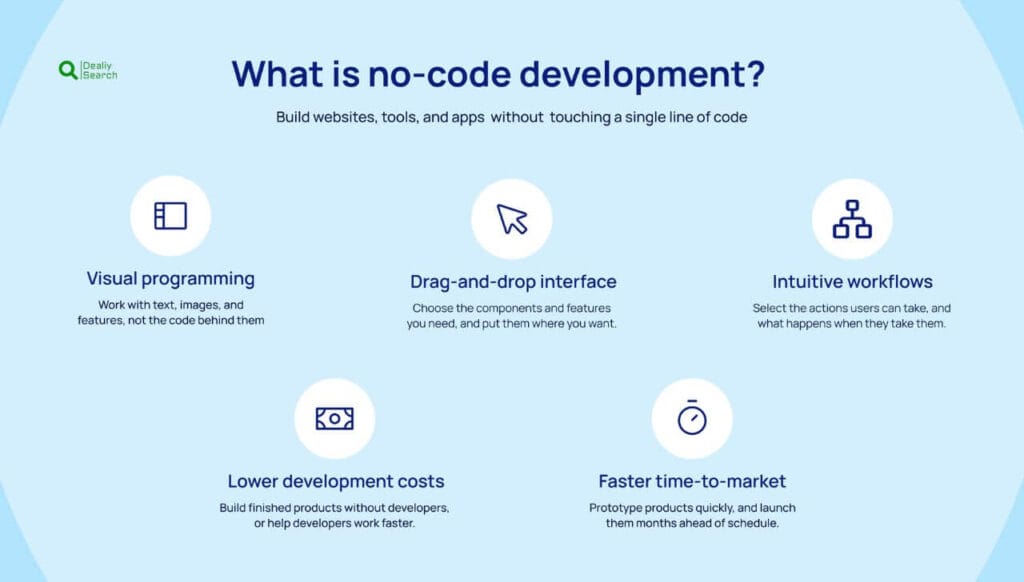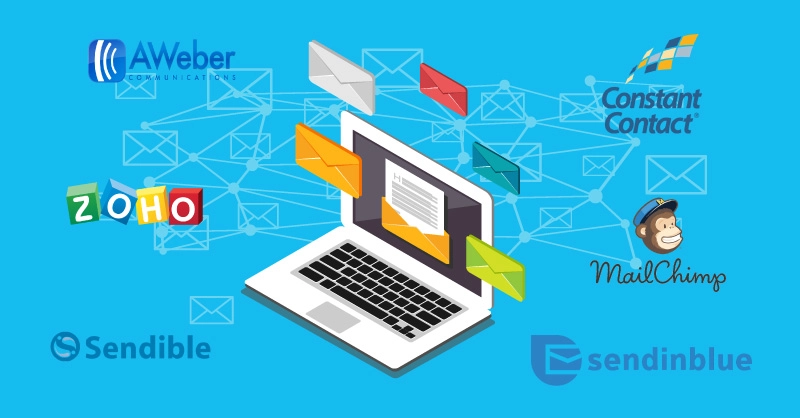No-Code Development The Future of Building Software Without Coding

No-Code development is revolutionizing the way software, websites, and applications are built by eliminating the need for traditional programming skills. It empowers individuals whether entrepreneurs, business owners, or creatives to bring their ideas to life using intuitive drag-and-drop interfaces, pre-built templates, and automation tools. By reducing reliance on developers, No-Code platforms accelerate digital innovation, cut costs, and make technology accessible to a wider audience. Whether you’re launching a startup, streamlining business operations, or building an MVP, No-Code development offers a faster and more efficient way to turn your vision into reality.
What is No-Code Development?

No-Code Development is a modern approach to software creation that allows users to build applications, websites, and digital solutions without writing code. Instead of traditional programming, no-code platforms use visual interfaces, drag-and-drop functionality, and pre-built templates to simplify development.
These platforms enable individuals regardless of technical expertise to design, automate, and deploy applications quickly. Businesses, startups, and entrepreneurs leverage no-code tools to streamline operations, develop prototypes, and launch digital products without hiring developers.
Popular no-code platforms include Bubble, Webflow, Adalo, Glide, Zapier, and Airtable, offering solutions for website design, app creation, workflow automation, and database management. With its speed, accessibility, and cost-effectiveness, no-code development is revolutionizing how software is built and democratizing access to technology.
No-Code Technologies & Developers
No-code technologies are platforms and tools that enable users to create software, websites, and applications without writing code. These technologies provide intuitive drag-and-drop interfaces, pre-built components, and automation features, allowing users to design, develop, and deploy digital solutions quickly. Which help build websites, mobile apps, automation workflows, and databases without traditional programming.
No-code developers are individuals who specialize in using these no-code platforms to create functional digital products. Unlike traditional developers who write code, no-code developers focus on assembling applications using visual builders, logic-based automation, and integrations. They help businesses and entrepreneurs build solutions efficiently without requiring deep coding knowledge. As no-code adoption grows, these developers play a crucial role in accelerating digital transformation and innovation.
Key Features of No-Code Development
No-code development simplifies the process of building applications, websites, and digital solutions without traditional programming. Here are its essential features:
- Visual Development Interface: Users can design applications using a drag-and-drop editor without writing code.
- Pre-Built Templates & Components: Ready-made UI elements, widgets, and templates accelerate development.
- Workflow Automation: Logic-based automation tools streamline business processes without manual intervention.
- Database Integration: Connect with built-in or third-party databases like Airtable, Google Sheets, or Firebase.
- API & Third-Party Integrations: Easily integrate with external services such as payment gateways, CRM tools, and analytics platforms.
- Responsive & Cross-Platform Design: No-code apps and websites automatically adjust for different screen sizes and devices.
- User Authentication & Access Control: Secure applications with built-in login systems, permissions, and user role management.
- Scalability & Cloud Hosting: Most no-code platforms offer cloud-based hosting, ensuring scalability and reliability.
- AI & Machine Learning Capabilities: Some platforms integrate AI features like chatbots, predictive analytics, and automation.
- Collaboration & Version Control: Teams can work together in real time, track changes, and revert to previous versions if needed.
These features make no-code development an efficient and cost-effective solution for businesses, startups, and entrepreneurs to quickly build and launch digital products.
How No-Code Development Works
No-code development works by providing users with visual tools and pre-built components to create applications without writing code. Instead of traditional programming languages, users interact with a drag-and-drop interface to design layouts, configure workflows, and integrate databases or third-party services. These platforms offer logic-based automation, allowing users to set up triggers, actions, and conditions to handle processes like form submissions, email notifications, and data updates.
No-code development also enables seamless integrations with APIs, payment gateways, and external tools such as Google Sheets, Zapier, or Stripe, making it easy to connect different services. Once the application is designed and configured, it can be deployed instantly with built-in hosting and cloud services. This approach significantly reduces development time, lowers costs, and allows businesses, entrepreneurs, and non-technical users to build functional applications quickly and efficiently.
How to Get Started with No-Code Development
Getting started with no-code development is easy, even if you have no technical background. Follow these steps to begin your no-code journey:
Understand Your Goals: Determine what you want to build, such as a website, mobile app, automation workflow, or database solution. Clearly define your project’s purpose and features.
Choose the Right No-Code Platform: Select a platform that aligns with your goals. For websites, use Webflow or Wix. For mobile apps, try Adalo or Glide. For automation, use Zapier or Make (Integromat). For databases, consider Airtable or Notion.
Learn the Basics: Explore the platform’s tutorials, online courses, and community forums to understand how to use its tools and features. Many platforms offer free resources to help beginners.
Experiment with Templates: Start with pre-built templates to familiarize yourself with the platform’s interface and functionalities before creating something from scratch.
Build a Simple Project: Begin with a small project, like a personal website, a to-do list app, or an automated email workflow, to practice working with no-code tools.
Integrate and Automate: Use APIs and automation tools to enhance your project. For example, connect a form submission to a database or set up an automatic email response using Zapier.
Test and Iterate: Run your project, test its functionality, and gather feedback. Make improvements based on user experience and refine your design or workflows.
Publish and Scale: Once your project is ready, deploy it using the no-code platform’s built-in hosting or export options. If needed, upgrade your plan to access advanced features and scale your solution.
Join No-Code Communities: Engage with other no-code developers in forums like No-Code Founders, Maker pad, or Indie Hackers to learn new strategies and stay updated.
Continue Learning and Experimenting: No-code development is constantly evolving. Keep exploring new platforms, tools, and integrations to expand your skills and build more advanced applications.
By following these steps, you can quickly create functional applications and leverage no-code development to bring your ideas to life.
Challenges of no-code development
No-code development offers many benefits, but it also comes with several challenges. One of the biggest limitations is the lack of flexibility and customization, as no-code platforms often have predefined templates and restricted functionalities that may not support complex or highly specialized applications. Scalability can also be a concern, as some platforms struggle to handle high-traffic loads or advanced database queries.
Additionally, vendor lock-in is a common issue, where users become dependent on a specific platform’s ecosystem and face difficulties migrating their projects to another service. Security and compliance can be another challenge, especially when handling sensitive data, as users have limited control over backend security measures. Moreover, no-code platforms often impose limitations on integrations and APIs, restricting how applications can connect with external tools.
Lastly, while no-code development simplifies software creation, learning how to optimize workflows and automate processes effectively still requires time and effort. Despite these challenges, no-code technology continues to improve, and with careful planning, businesses can leverage it to develop functional and efficient digital solutions.
Use Cases of No-Code Development
No-code development is widely used across various industries, enabling individuals and businesses to build digital solutions quickly and efficiently. One of the most common use cases is website and landing page creation, where platforms like Webflow and Wix allow users to design responsive websites without coding. Mobile and web app development is another key area, with tools like Adalo and Glide helping entrepreneurs build MVPs (Minimum Viable Products) for startups.
Businesses also leverage no-code for workflow automation, using platforms like Zapier and Make to automate repetitive tasks such as email notifications, data transfers, and CRM updates. E-commerce solutions can be built using Shopify, enabling small businesses to launch online stores with ease. Additionally, companies use no-code tools for internal dashboards, database management, and AI-powered chatbots, improving efficiency and customer engagement. No-code development empowers innovation while reducing costs and development time.
Benefits & disadvantages of no-code development
No-code development enables quick, cost-effective app creation without coding but has limitations like scalability, customization constraints, vendor lock-in, and security concerns for complex projects.

Benefits of No-Code Development
- Faster Development: No-code platforms significantly reduce development time, allowing users to create and launch applications quickly.
- Cost-Effective: Eliminates the need for hiring developers, reducing software development costs for startups and businesses.
- Accessibility: Enables non-technical users to build applications without coding knowledge, making technology more inclusive.
- Drag-and-Drop Simplicity: Visual interfaces and pre-built components make app development easy and intuitive.
- Easy Maintenance & Updates: Changes and updates can be made quickly without requiring technical expertise.
- Automation & Integration: No-code tools connect with third-party applications and automate workflows efficiently.
- Scalability for Simple Projects: Ideal for small to medium-sized applications, prototypes, and internal tools.
Disadvantages of No-Code Development
- Limited Customization: No-code platforms may not support complex functionalities or unique business needs.
- Scalability Challenges: Some platforms struggle to handle high traffic, large databases, or advanced performance requirements.
- Vendor Lock-In: Users are often dependent on specific platforms, making it difficult to migrate to another service.
- Security & Compliance Risks: Limited control over security measures may pose risks, especially for handling sensitive data.
- Integration Limitations: Not all third-party services and APIs are supported, restricting customization options.
- Learning Curve for Optimization: While no-code is easy to start, mastering automation and efficient workflows requires time.
- Less Control Over Backend Development: Users rely on the platform’s infrastructure, which may not be as flexible as traditional coding.
Despite these disadvantages, no-code development remains a powerful tool for building applications efficiently, making it ideal for startups, small businesses, and internal process automation.
Frequently Asked Question
Here are some frequently asked about this topic:
What is No-Code Development and how does it work?
It allows users to create applications using visual tools, drag-and-drop interfaces, and pre-built components instead of coding. Users design workflows, integrate databases, and automate processes, making it accessible for businesses and individuals without technical expertise.
What are the main benefits of No-Code Development?
It speeds up development, reduces costs, and allows non-technical users to build apps easily. Businesses can automate workflows, integrate tools, and launch digital solutions without hiring developers, making it an efficient and scalable option for startups and enterprises.
Are there any limitations to No-Code Development?
It has customization, scalability, and integration limitations compared to traditional coding. Some platforms may restrict advanced functionality, and vendor lock-in can be a concern, making migration or expansion challenging for complex applications.
Who can use No-Code Development?
Entrepreneurs, small businesses, and enterprises can use it to build websites, mobile apps, automation workflows, and databases. It is ideal for non-technical users, marketers, and product managers who need quick, efficient solutions without relying on developers.
Can No-Code Development replace traditional coding?
It is useful for building simple to moderately complex applications but cannot fully replace traditional coding for highly customized, large-scale, or advanced software solutions requiring deep backend control and specialized development.
Related Post: The Ultimate Guide to Web Application Monitoring Ensuring Performance
Conclusion
No-Code Development is revolutionizing the way individuals and businesses create digital solutions by eliminating the need for traditional coding. With its user-friendly visual interfaces, automation capabilities, and rapid development process, it empowers non-technical users to build websites, apps, and workflows efficiently. While it offers significant advantages such as cost savings, faster deployment, and accessibility, it also has limitations in scalability, customization, and integration.
Despite these challenges, no-code technology continues to evolve, making it a valuable tool for startups, enterprises, and innovators looking to streamline their digital transformation. As more advanced features and AI-driven automation are integrated into no-code platforms, their potential will only grow, bridging the gap between technical and non-technical users in software development.






